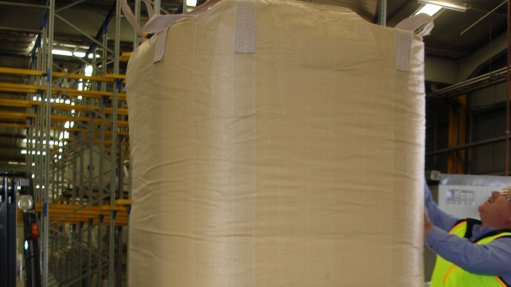
SAFE STACKING The integrated sleeves of the Tellap bag form a solid base and increases the safe stacking height
Handling high-value minerals requires the optimum protection of the transported goods, as product contamination and damage are expensive, and could ultimately tarnish a company’s reputation, says pallet-free bulk bags manufacturer Tellap director Ken Mouritzen.
He tells Mining Weekly that a key issue for logistics in the mining sector is the need for a safe, reliable and efficient packaging and transport system that is also environmentally sustainable.
Mouritzen says mine logistics managers often highlight their concerns about high costs, potential product contamination and securing the safety of transported goods.
In addition, logistics managers also highlight using nonenvironment-friendly wooden pallets as an impediment to business efficiency.
“Although the acceptance of bulk bags has resulted in positive changes in global packaging and transport trends, the inherent problems of wooden pallets – including heaviness, occupying vast areas of space, harbouring germs and their being difficult to recycle – on which bulk bags are typically transported, still exist. “For this reason, industry has been forced to consider packaging alternatives.”
Mouritzen says one such alternative is the company’s locally developed pallet-free bulk bag system. The company manufactures this customisable packaging system, designed for enhanced safety and efficiency, and is manufactured from 100% recyclable polypropylene.
He says the Tellap system, comprising a bulk bag and two strong integrated plastic sleeves, weighs only 5 kg.
By removing the pallets, the bulk bag removes dead weight, which can be up to 35 kg per wooden pallet, and replaces it with the transported product, which lowers transport costs.
He notes that removing the pallets enables up to 10% more product to be transported at no extra cost.
“The high-strength sleeves are integrated into the base of the Tellap bag to replace the pallet, allowing for a standard forklift truck to raise the bag from the base. “Thus, there is no requirement for special handling equipment,” Mouritzen elaborates.
He also notes that the integrated sleeves of the Tellap bag form a solid base and the stability resulting from this increases the safe stacking height and reduces storage and warehouse space requirements.
He adds that raising the bag from the base provides better vision and stability, while enabling a single operator to handle the bags easily, quickly and efficiently.
Mouritzen further notes that the Tellap bag is 100% plastic and is International Standards For Phytosanitary Measures No 15-compliant.
The bag is also certified by global packaging component testing specialist TEN-E Packaging Services, and meets the performance requirements for nondangerous goods contained in flexible intermediate bulk containers, says Mouritzen.
“This international certification and Tellap’s in-house controls ensure that every customer consistently receives a safe quality product fit for their specific packaging purpose.”
Mining Industry Uptake
Mouritzen tells Mining Weekly that the mining industry has become aware of the instability of conventional bags and wooden pallets, especially when stacked, which is why many companies have introduced a single-stack rule.
Although the Tellap bag has been available since 2009, the company only recently started targeting the mining industry and is in discussions with several mining companies, says Mouritzen.
He notes that global metals and minerals trader and supplier Dickinson’s Metallurgical Supplies is using the Tellap bag to transport products to its customers.
Mouritzen explains that the introduction of a new packaging and transport solution takes time because it has to be subjected to trials, as well as testing and safety procedures.
“The safety of workers and the product is important to Tellap; therefore, the company does not cut corners, as it aims to establish long-term business relationships.”
He adds that feedback from companies in other industrial sectors that have been using the Tellap bag has been positive.
He further highlights that, with a new solution, communication is critical, noting that all participants must understand the Tellap bag and how it is handled. “Therefore, we have training documentation to help educate clients.”